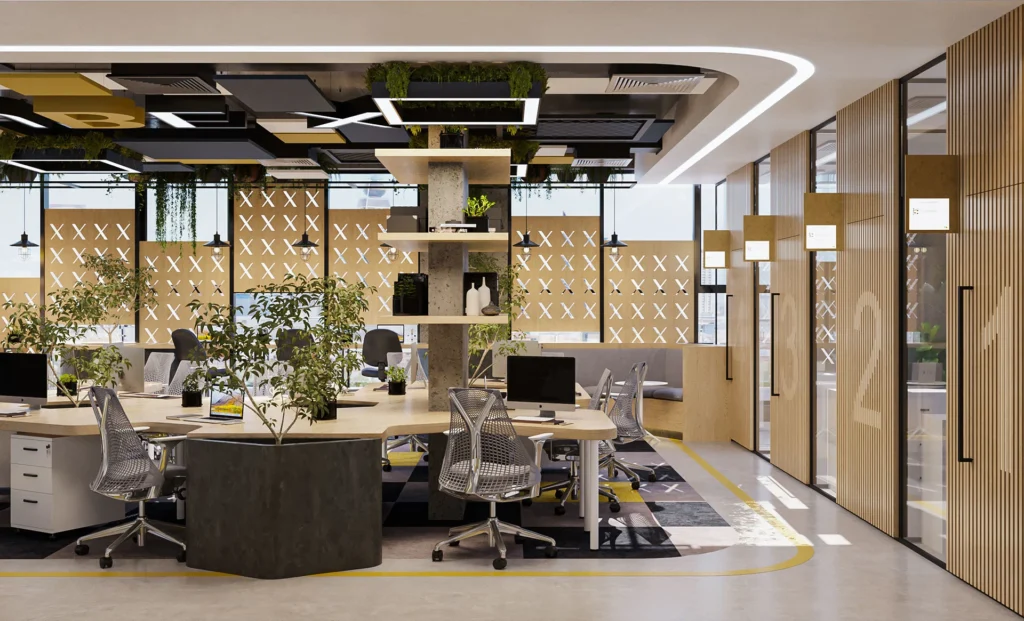When we think of office design, our minds often gravitate toward desks, color schemes, or lighting — rarely do we look up. But the ceiling, often dubbed the “fifth wall,” holds immense potential in transforming the atmosphere of a workspace. From plain and neglected to bold and inspiring, office ceilings are emerging as powerful design elements that contribute to both aesthetics and productivity.
1. The Forgotten Canvas
For years, office ceilings have been reduced to flat, white panels or uninspiring tiles. This approach, rooted in uniformity and utility, often overlooks the psychological and visual impact ceilings can have. A dull ceiling may go unnoticed, but a dynamic one has the power to elevate a workspace — literally and figuratively.
2. The Rise of Dynamic Ceiling Design
Modern workspaces are evolving to prioritize creativity, well-being, and brand identity. Ceiling designs are now reflecting this shift, incorporating:
-
Suspended or false ceilings with layered designs and hidden lighting.
-
Acoustic ceiling panels that reduce noise and add texture.
-
Exposed industrial ceilings that bring a raw, modern edge.
-
Wooden beams or slats for warmth and biophilic design.
-
Customized ceiling graphics or murals that reflect brand ethos.
These innovative elements are not just decorative — they improve light diffusion, acoustics, and overall ambiance.
3. Function Meets Form
The best ceiling designs are those that seamlessly blend utility with creativity. For instance:
-
Open grid ceilings maintain easy access to wiring and HVAC systems while creating an edgy, open feel.
-
Lighting integration with LED strips, pendant fixtures, or diffused skylights creates dynamic visual flow and energy.
-
Modular ceiling tiles allow for easy maintenance and frequent design refreshes.
Such multifunctional solutions are ideal for coworking spaces, corporate offices, creative studios, and even law firms seeking a modern yet professional look.
4. Psychological Impact of Ceilings
Ceilings affect how we feel in a space. High ceilings are often linked to openness and creative thinking, while lower ceilings can foster focus and intimacy. By using design strategically, organizations can influence how employees think, feel, and perform:
-
Color: Warm tones can create comfort, while cool hues may evoke calm and focus.
-
Patterns: Organic patterns can reduce stress, while geometric shapes promote structure and clarity.
-
Height manipulation: False ceilings or lighting tricks can visually adjust the ceiling’s height to suit the space’s function.
5. Sustainability and Smart Design
With the growing emphasis on sustainable architecture, ceilings are now being built with eco-conscious materials such as recycled wood, bamboo, or low-VOC finishes. Smart ceilings are also gaining popularity — integrating sensors for lighting and air quality to enhance energy efficiency and workplace health.
6. The Ceiling as a Branding Element
For businesses, the ceiling is a canvas for storytelling. Whether it’s a company logo subtly embedded in the ceiling design or a visual journey across departments, ceilings can reinforce identity and values in a subtle yet striking way.
Conclusion
In the evolving world of interior design, ceilings are no longer afterthoughts — they are design statements. From dull to dynamic, the right ceiling design can redefine an office’s energy, style, and function. It’s time to look up and rethink the way we shape our workspaces — because inspiration can come from above.

